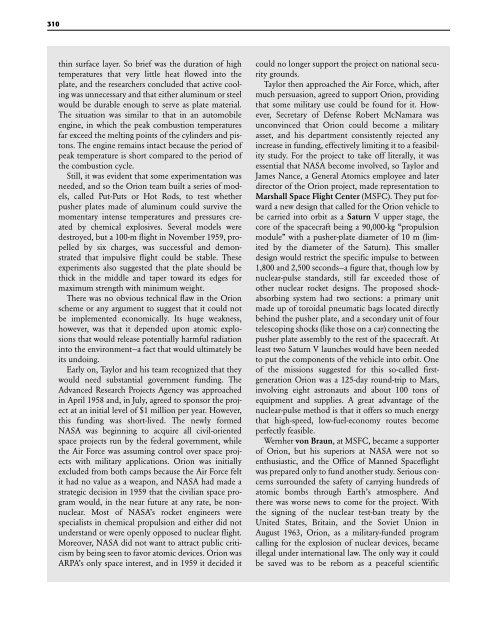The Complete Book of Spaceflight: From Apollo 1 to Zero Gravity
The Complete Book of Spaceflight: From Apollo 1 to Zero Gravity
The Complete Book of Spaceflight: From Apollo 1 to Zero Gravity
Create successful ePaper yourself
Turn your PDF publications into a flip-book with our unique Google optimized e-Paper software.
310<br />
thin surface layer. So brief was the duration <strong>of</strong> high<br />
temperatures that very little heat flowed in<strong>to</strong> the<br />
plate, and the researchers concluded that active cooling<br />
was unnecessary and that either aluminum or steel<br />
would be durable enough <strong>to</strong> serve as plate material.<br />
<strong>The</strong> situation was similar <strong>to</strong> that in an au<strong>to</strong>mobile<br />
engine, in which the peak combustion temperatures<br />
far exceed the melting points <strong>of</strong> the cylinders and pis<strong>to</strong>ns.<br />
<strong>The</strong> engine remains intact because the period <strong>of</strong><br />
peak temperature is short compared <strong>to</strong> the period <strong>of</strong><br />
the combustion cycle.<br />
Still, it was evident that some experimentation was<br />
needed, and so the Orion team built a series <strong>of</strong> models,<br />
called Put-Puts or Hot Rods, <strong>to</strong> test whether<br />
pusher plates made <strong>of</strong> aluminum could survive the<br />
momentary intense temperatures and pressures created<br />
by chemical explosives. Several models were<br />
destroyed, but a 100-m flight in November 1959, propelled<br />
by six charges, was successful and demonstrated<br />
that impulsive flight could be stable. <strong>The</strong>se<br />
experiments also suggested that the plate should be<br />
thick in the middle and taper <strong>to</strong>ward its edges for<br />
maximum strength with minimum weight.<br />
<strong>The</strong>re was no obvious technical flaw in the Orion<br />
scheme or any argument <strong>to</strong> suggest that it could not<br />
be implemented economically. Its huge weakness,<br />
however, was that it depended upon a<strong>to</strong>mic explosions<br />
that would release potentially harmful radiation<br />
in<strong>to</strong> the environment—a fact that would ultimately be<br />
its undoing.<br />
Early on, Taylor and his team recognized that they<br />
would need substantial government funding. <strong>The</strong><br />
Advanced Research Projects Agency was approached<br />
in April 1958 and, in July, agreed <strong>to</strong> sponsor the project<br />
at an initial level <strong>of</strong> $1 million per year. However,<br />
this funding was short-lived. <strong>The</strong> newly formed<br />
NASA was beginning <strong>to</strong> acquire all civil-oriented<br />
space projects run by the federal government, while<br />
the Air Force was assuming control over space projects<br />
with military applications. Orion was initially<br />
excluded from both camps because the Air Force felt<br />
it had no value as a weapon, and NASA had made a<br />
strategic decision in 1959 that the civilian space program<br />
would, in the near future at any rate, be nonnuclear.<br />
Most <strong>of</strong> NASA’s rocket engineers were<br />
specialists in chemical propulsion and either did not<br />
understand or were openly opposed <strong>to</strong> nuclear flight.<br />
Moreover, NASA did not want <strong>to</strong> attract public criticism<br />
by being seen <strong>to</strong> favor a<strong>to</strong>mic devices. Orion was<br />
ARPA’s only space interest, and in 1959 it decided it<br />
could no longer support the project on national security<br />
grounds.<br />
Taylor then approached the Air Force, which, after<br />
much persuasion, agreed <strong>to</strong> support Orion, providing<br />
that some military use could be found for it. However,<br />
Secretary <strong>of</strong> Defense Robert McNamara was<br />
unconvinced that Orion could become a military<br />
asset, and his department consistently rejected any<br />
increase in funding, effectively limiting it <strong>to</strong> a feasibility<br />
study. For the project <strong>to</strong> take <strong>of</strong>f literally, it was<br />
essential that NASA become involved, so Taylor and<br />
James Nance, a General A<strong>to</strong>mics employee and later<br />
direc<strong>to</strong>r <strong>of</strong> the Orion project, made representation <strong>to</strong><br />
Marshall Space Flight Center (MSFC). <strong>The</strong>y put forward<br />
a new design that called for the Orion vehicle <strong>to</strong><br />
be carried in<strong>to</strong> orbit as a Saturn V upper stage, the<br />
core <strong>of</strong> the spacecraft being a 90,000-kg “propulsion<br />
module” with a pusher-plate diameter <strong>of</strong> 10 m (limited<br />
by the diameter <strong>of</strong> the Saturn). This smaller<br />
design would restrict the specific impulse <strong>to</strong> between<br />
1,800 and 2,500 seconds—a figure that, though low by<br />
nuclear-pulse standards, still far exceeded those <strong>of</strong><br />
other nuclear rocket designs. <strong>The</strong> proposed shockabsorbing<br />
system had two sections: a primary unit<br />
made up <strong>of</strong> <strong>to</strong>roidal pneumatic bags located directly<br />
behind the pusher plate, and a secondary unit <strong>of</strong> four<br />
telescoping shocks (like those on a car) connecting the<br />
pusher plate assembly <strong>to</strong> the rest <strong>of</strong> the spacecraft. At<br />
least two Saturn V launches would have been needed<br />
<strong>to</strong> put the components <strong>of</strong> the vehicle in<strong>to</strong> orbit. One<br />
<strong>of</strong> the missions suggested for this so-called firstgeneration<br />
Orion was a 125-day round-trip <strong>to</strong> Mars,<br />
involving eight astronauts and about 100 <strong>to</strong>ns <strong>of</strong><br />
equipment and supplies. A great advantage <strong>of</strong> the<br />
nuclear-pulse method is that it <strong>of</strong>fers so much energy<br />
that high-speed, low-fuel-economy routes become<br />
perfectly feasible.<br />
Wernher von Braun, at MSFC, became a supporter<br />
<strong>of</strong> Orion, but his superiors at NASA were not so<br />
enthusiastic, and the Office <strong>of</strong> Manned <strong>Spaceflight</strong><br />
was prepared only <strong>to</strong> fund another study. Serious concerns<br />
surrounded the safety <strong>of</strong> carrying hundreds <strong>of</strong><br />
a<strong>to</strong>mic bombs through Earth’s atmosphere. And<br />
there was worse news <strong>to</strong> come for the project. With<br />
the signing <strong>of</strong> the nuclear test-ban treaty by the<br />
United States, Britain, and the Soviet Union in<br />
August 1963, Orion, as a military-funded program<br />
calling for the explosion <strong>of</strong> nuclear devices, became<br />
illegal under international law. <strong>The</strong> only way it could<br />
be saved was <strong>to</strong> be reborn as a peaceful scientific







